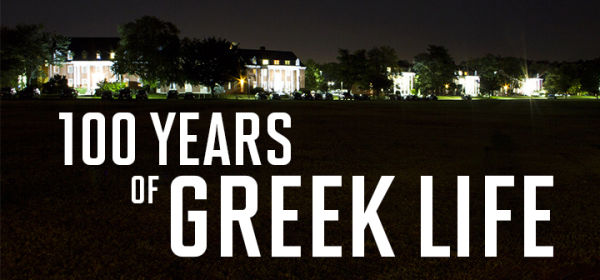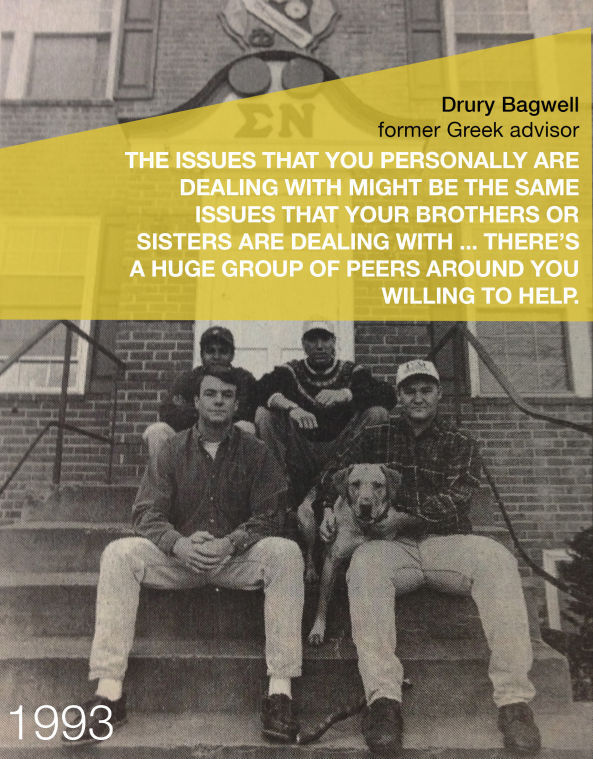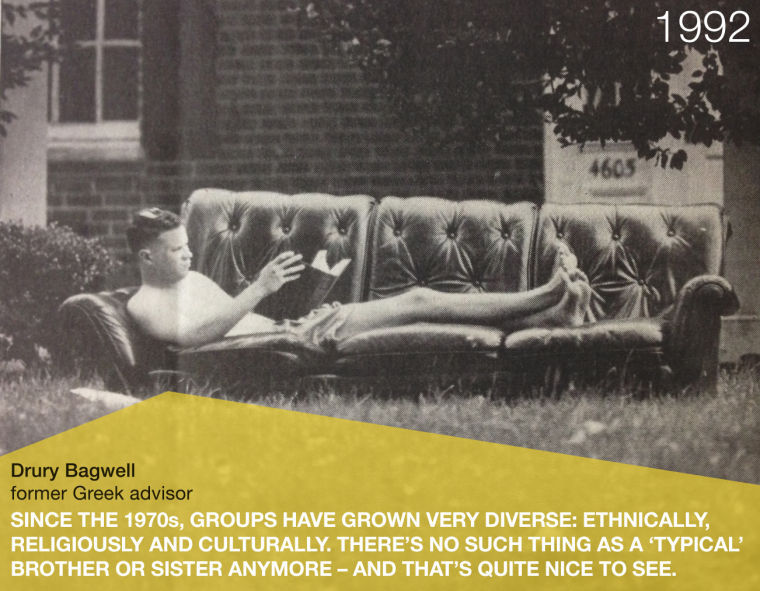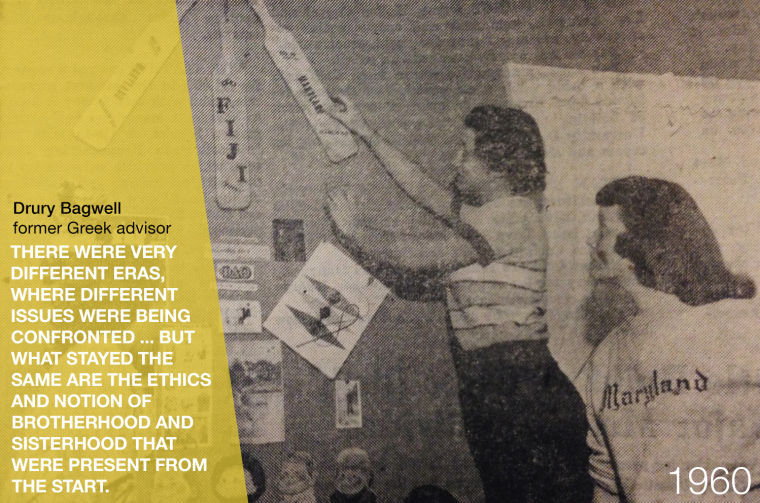Ask the average university student what Greek life means to him or her and you’ll get a range of answers — from friendship to red Solo cups, hazing to philanthropy, intramurals to drugs.
But there’s no question that Greek life plays a significant role on the campus. About 12 percent of the student body is involved, and the subculture impacts the lives of hundreds more, from the city residents who call fraternity and sorority members neighbors to the school and city officials who work with them to craft policies.
2013 marks the 100th year of a university-recognized Greek presence on campus. This century-long relationship, full of ups and downs, has grown and thrived over the years, culminating in the 56 Department of Fraternity and Sorority Life-recognized chapters and more than 30 other social, cultural, religious, academic and service Greek organizations.
FROM THE ASHES
On Nov. 29, 1912, the Great Fire devastated the young university — then called the Maryland Agricultural College. Buildings burned to the ground as the fire raged, completely destroying the military barracks and leaving behind few classrooms.
Displaced students were sent into the College Park community to board in the homes of long-term residents while the university nursed its wounds. It was here where the seeds of fraternity life first started, later developing into the Greek system we know today.
“These young men were sent out into the community, but could come together and run a household in true fraternity style,” said Bob Nichols, associate DFSL director. “The school was drastically different and students needed a place to live. That’s where fraternity life at Maryland really began.”
Unlike traditional fraternal societies at the time, which were sprouting up at colleges across the nation, the primary purpose of this university’s chapters was to provide displaced students living quarters rather than a place to socialize, Nichols said. With no major dormitories left after the Great Fire, students pieced together the first fraternities from the ashes, creating their own college community.
The university recognized its first fraternity, Gamma Pi, which later became Sigma Nu, on Sept. 18, 1913. Following the admittance of female students on campus in 1916, the first sorority, Sigma Delta, which later changed its name to Kappa Alpha, was recognized in 1920.
March 24, 1913 saw the first mention of Greek life in the school’s new organizations: In an article published in the school’s weekly newspaper, students described fraternity life.
Then-college President Harry J. Patterson said in the article he dreamed of chapter houses, which would enable students to live in a “truly fraternal relationship.”
Not everyone at the university embraced the Greek chapters with open arms, though.
In the university’s 1913-1914 yearbook, editors cautioned against typical fraternities, expressing distaste for their “clannishness, which can easily develop into snobbishness” and encouraging Maryland Agricultural College students to protect themselves from this potential development.
“While this evil has not been apparent at M.A.C., it will be necessary to guard against it very carefully,” students wrote. “The fraternity members should make every effort to counteract this tendency by engaging actively in other phases of student life.”
And join in student life they did — entering every facet of the community, Nichols said. It was hard to find in that time, or even today, an organization with no Greek members or Greek involvement.
CHANGING WITH THE TIMES
Years passed and each new generation of students brought along new issues and influences. Still, fraternities and sororities survived, offering students a group with which to share their common experiences throughout the decades.
“The issues that you personally are dealing with might be the same issues that your brothers or sisters are dealing with,” said Drury Bagwell, former Greek life adviser and vice president of student affairs. “There’s a huge group of peers around you willing to help.”
Click to enlarge

Pull quote 1993
Of course, today’s university students are far different from the students of the ’50s or ’60s. Fraternities and sororities changed as the student body and country did.
Greek life took off after World War II and entered a golden age at the university with the postwar entrance of veteran students, Bagwell said. But the returning soldiers brought with them experiences that the average 18- or 19-year-old college student may not have had.
By all accounts, the idea of hazing is believed to have first started in this time period, as war-hardened returning soldiers’ perspectives changed university life.
“After the war, these soldiers were coming back from boot camp, from killing people, and they started mixing with kids just out of high school,” Bagwell said. “There was an element of ‘We’re men, we’re gonna make you men’ that started hazing.”
That harsher outlook wasn’t just limited to Greek life. The “Boulevard Riot” of 1949, a precursor to recent Route 1 riots, grew largely out of the post-war student body, Nichols said. Excited students at a pep rally got out of hand and the chaos ended when police brought out tear gas. Newspaper headlines called it the worst riot the school had seen.
Through the ’50s and ’60s, students embraced Greek life, drawing record numbers and dominating the school’s social life. Headlines of The Diamondback detailed events on the Greek social calendar and the Interfraternity Council held annual concerts that drew students Greek and non-Greek alike.
With the start of the Vietnam War, fraternity membership dropped dramatically, Bagwell said. The prevailing thought at the time in the nation, and at the university, was “Everyone should do their own thing,” not join organizations. People as a whole grew distrustful of governing bodies and declining numbers of Greek life members reflected that.
Eventually, as society began to emphasize building careers and futures, students began to go Greek again, believing the experience of being in a fraternity or sorority would help them in their future careers.
Through the years, this university’s landscape changed dramatically, but Greek chapters’ values and principles stayed constant.
“If I could sum up the hundred years, I would say there were very different eras, where different issues were being confronted,” Bagwell said. “But what stayed the same are the ethics and notion of brotherhood and sisterhood that were present from the start.”
Click to enlarge

Pull quote 1960
AN ENDURING LEGACY
When Bagwell came to the university, the year was 1974 and the Vice President of Student Affairs was a man named Dr. William Thomas. Thomas dreamed of revitalizing the Greek system and believed Bagwell was the man for the job.
For nearly thirty years, Bagwell would donate his time and his career to the university’s fraternities and sororities, serving as Greek adviser and later vice president of student affairs until his retirement in 2001.
“I want to make it clear: I’m not 100 years old,” Bagwell said, laughing. “I’ve been around for a long time, but I haven’t been here since the beginning. That doesn’t mean I haven’t seen some changes, though.”
These changes — adaptations to the university view of Greek life and the way Greek students see their chapters — came from Bagwell and from the students themselves, as they worked to improve relations and standards.
The current Department of Fraternity and Sorority Life, the largest of its kind in the nation, according to Nichols, came about largely in part to Bagwell’s influence and his view of the Greek community.
He says he sees the opportunity to join fraternities and sororities as a way to live up to the ideals and values that each chapter puts forth, allowing students to grow as people during their time in college.
As he puts it, “you don’t have to be in a fraternity or sorority to have fun, don’t have to be in a Greek group to drink beer, to have a house to live in, or to have friends.”
Instead, he argues, the reason so many students should — and do — take advantage of the opportunity to join the Greek community is to learn how to live the values.
This belief in core values prompted Bagwell and other administrators at the time to create a “Greek vision” in the 1990s. In Bagwell’s words, the policy stated if Greek groups are “going to be on our campus, we expect [them] to live up to the ideals that [they] profess.
Most importantly, though, Bagwell and the current DFSL office stress the importance of working with Greek life members, teaching them and helping them to grow as people.
This, according to Bagwell, is what separates this university’s Greek community from other colleges and chapters across the country.
Nichols describes it as a choice the university made long ago and continues to uphold.
“The school faced a decision: either engage in Greek life 100 percent, or pull away, withdraw completely,” Nichols said. “They recognized that the positives outweigh the negatives, and committed fully — they made a good choice, clearly, and the university is benefiting today.”
RELATIONSHIP WITH THE UNIVERSITY
The Greek community, this university and the city of College Park have had a love-hate relationship in many ways over the 100-year span. Opinions of fraternities and sororities have ebbed and flowed as decades passed, said university archivist Anne Turkos.
“The relationship hasn’t always been the best,” Turkos said. “But as a whole, the university embraces that part of its student body, just as it would any other.”
Following the establishment of the Office of Greek Life in 1974 and subsequent expansions to the department, the university has played an active role in monitoring the fraternities and sororities, taking action when necessary, but recognizing the benefits Greek life has on the community as well.
Particularly, Turkos mentioned, the Greek community has made “incredible differences in people’s lives through their philanthropic efforts,” donating thousands of hours to service in the community, fundraising and charity work.
Today, the GPA of Greek life members is higher than the national average. At this university, the average GPA of the Greek life community is above a 3.0, with fraternities averaging a 3.13 and sororities averaging a 3.32 in spring of 2013.
Fraternities and sororities on campus have largely shaped the nature of homecoming, hosting parades, chariot and boat races and Homecoming Queen contests in the past. They have a strong Greek Week tradition that continues today, encouraging relationships and interaction between chapters.
Though at times the university has had to take disciplinary actions against chapters, most fraternities and sororities adhere to the values and expectations set out by administrators. And, DFSL Director Matt Supple said, the movement of chapters on and off campus is natural.
“Over time, chapters have closed and come back, for many different reasons,” Supple said. “Sometimes there aren’t enough interested members, sometimes they’ve done something warranting university response. The chapters are made up of college students — it’s natural they’ll make mistakes, grow and learn.”
Click to enlarge

Pull quote 1992
As the landscape of the fraternities and sororities on campus changed, so too has the makeup of the chapter members and the type of Greek community represented.
New historically African-American, Hispanic and Asian-American communities developed, and traditionally white groups have admitted more diverse members into each successive class, Nichols said. This semester saw the establishment of the first LGBT chapter on campus.
“It really is remarkable how diverse the Greek community has become,” Bagwell said. “Since the 1970s, groups have grown very diverse: ethnically, religiously and culturally. There’s no such thing as a ‘typical’ brother or sister anymore — and that’s quite nice to see.”
Read more
[ READ MORE: Steny Hoyer talks Greek life ][ READ MORE: Sigma Chi members, local residents debate fraternity’s abandoned house ]
Interactive timeline
1993
1992
1960







